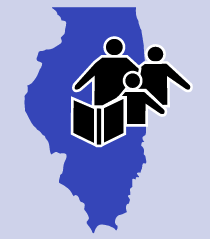
Family Reading Time
Take a break. Turn off your screen and grab a book. Read for yourself or read with your child.
Did you know that reading your child a book, magazine, or newspaper in front of your child makes an impression on them? It does! Young children, even babies, who watch their family members read grow up to be great readers, too.
Books Galore
One thing you can do to help your child develop a love for reading is to have books available in your home. Go to the public library with your child and browse some books. Get what seems to interest your child as well as books that interest you. See some great options for very young children in our resource guide on page 3 of this newsletter. Once you check out the books (for free!) from a library, you can place several of them around your house at your child’s eye-level so your child can see the books and choose to explore them.
Over and Over Again
Infants and toddlers learn so much from being read to. Make it a routine to read to your child every day, if you can. Sometimes children may request their favorite book over and over again. This is a wonderful way for children to learn new words and gain vocabulary—just some of the skills needed for a reader. Sometimes children want to skip ahead a few pages or stay on a page longer. That’s okay! Follow your child’s lead and pace. You can even forget the words on the page and tell your own story. Make it up; make it fun!
Rrrr-Roar
Making the noises of the characters on the page helps engage young children. For example, if there is a bear in the story, you could lower your voice when you read the bear’s words and even growl a little, too: “Gggrrrrr.!” It’s okay for adults to act and feel silly when reading; this can even reduce your stress. Little ones love to hear the noises of the animals! It makes the story come alive for them.
Do You See the Little Girl?
Simply talking together about the pictures on the page helps your child’s brain grow. Pointing to a picture helps very young children develop joint attention, when a child and an adult are looking at the same thing together. For example, you might say while pointing to the picture in the book, “Do you see that little girl? What is she doing?” Child: “Run.” You: “Yes, she is running! She is wearing a red coat.” This back and forth conversation is called “serve and return” language, which helps children develop cognitive skills. What is most important is that you are spending time together and having a good time.
So whenever you have a few minutes in the day, curl up with your child and enjoy a good book together. The benefits to your child, and you, are endless.
COVID-19 Resources from Illinois Early Learning
With COVID-19, our daily routines and activities have greatly changed. We are highlighting some resources that our sister project, Illinois Early Learning (IEL), has created to support families of young children.
One of IEL’s most popular resources during the pandemic has been the Keeping Healthy and Safe: Face Coverings tip sheet. In this graphic tip sheet, family members and professionals can learn how to best help children wear a face covering. (Note: Face coverings are only recommended for children age 2 and older.)
Many family members may also be experiencing added stress during the pandemic. The COVID-19 Parenting Pep Talk blog series has some great advice for parents. We are highlighting two for families involved in early intervention: Be With Your Child’s Big Feelings and Make Time for Connection. Both of these blog posts can help you better manage struggles at home. This series addresses day-to-day parenting challenges during COVID-19.
For these and more resources, visit IEL’s COVID-19 Resources web page at https://illinoisearlylearning.org/group/covid-19/
Planning for Early Intervention During COVID-19
The Bureau of Early Intervention has created a team of stakeholders, including families, to develop a plan for early intervention during COVID-19. The purpose of the plan is to ensure the safety of families while also ensuring access to early intervention services. For more weekly updates about the workgroup, see http://www.wiu.edu/coehs/provider_connections/bureau/covid_info/index.php
Currently, families have three ways to receive early intervention services: in-person, live video visits, and phone consultation. For more information about each option:
- Watch this webinar about early intervention
https://www.fmptic.org/recordings/family-matters-recordings/4494
Regarding the live video visits, if you need technology (e.g., devices, Internet access), you may consider:
- Review this link to find resources to secure technology and Internet access
http://www.wiu.edu/coehs/provider_connections/pdf/20200406livevideovisits.pdf - The Early Intervention Clearinghouse is loaning technology (i.e., iPads with data plans, iPads with Wi-Fi, and hotspots) to families for free
https://eiclearinghouse.org/resources/techloan/ - Rush University has a research project that will enable families to access technology for early intervention. Please contact Lauren Little for more information at (312) 942-1759 or lauren_little@rush.edu.
State Systemic Improvement Plan (SSIP) Update
As we head into the final year of our SSIP, we continue to focus on family engagement as a way to enhance families’ capacity to meet the developmental needs of their infants and toddlers. The recent shift in service delivery has allowed more teams to implement coaching strategies that build on family strengths. While some of the activities in our plan have unfortunately been delayed, we will continue to move forward when it is safe to do so. In the interim, we are doing all we can to help families continue to meet their outcomes while staying safe!
Related Resource(s)
- Tip Sheets: Having Safe In-Person Early Intervention Visits
- Resource Guides: Fun Books for Families

